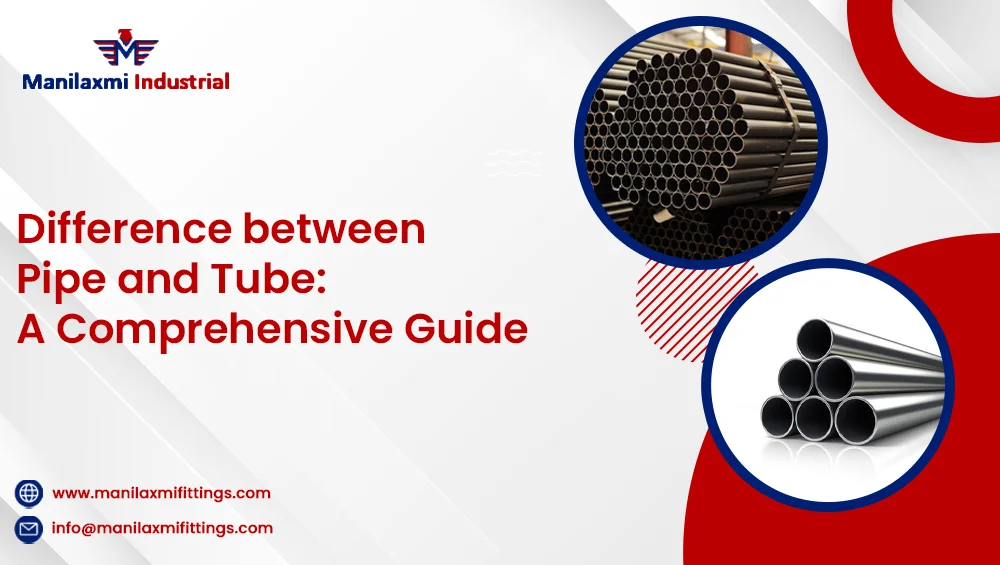
Difference between Pipe and Tube : A Comprehensive Guide
Pipes and tubes are critical additives in industrial and business applications, yet the terms are regularly used interchangeably, leading to confusion. While they will look similar, their specs, manufacturing standards, and applications vary substantially. Understanding those variations is critical for deciding on the proper product in your desires. In this guide, we’ll explore the difference between pipe and tube as per asme, protecting dimensions, making use of substances, and requirements.
What is the Difference Between Pipe and Tube?
The simple distinction between pipe and tube lies in how they're described and used. Pipes are typically used to move fluids or gases and are measured by their internal diameter (ID). Tubes, then again, are regularly structural and are measured by means of their out of doors diameter (OD). Below, we spoil down the number one differences:
1. Measurement Standards
- Pipe: Measured by using nominal diameter and wall thickness (schedule). The focus is on potential.
- Tube: Measured by specific outdoor diameter and wall thickness. The cognizance is on precision and structural integrity.
2. Applications
- Pipe: Commonly utilized in plumbing, oil and gas pipelines, and fluid delivery structures.
- Tube: Found in structural programs, automotive parts, and clinical gadgets.
3. Material Strength
- Pipe: Prioritizes strain managing and glide extent.
- Tube: Often emphasizes tensile strength and versatility.
4. Standards and Specifications
- Pipes adhere to standards consisting of ASME B36.10 and ASME B36.19 for dimensions and tolerances.
- Tubes are ruled by using requirements like ASTM A213 for precision and material consistency.
5. Shape and Design
- Pipe: Typically round to facilitate fluid flow.
- Tube: Can be spherical, square, or rectangular, relying on the software.
Key Differences as in line with ASME Standards
The distinction between pipe and tube as in line with ASME is essentially related to the tolerances and specifications. Pipes below ASME requirements are designed for high-stress programs and prioritize glide, at the same time as tubes meet tighter tolerances and are used in more precision-oriented industries.
Pipes vs. Tubes in Bending Applications
When using a bender, understanding the difference between pipe and tube bender is important:
- Pipe Bender: Designed for thicker partitions and large diameters, accommodating the nominal sizing of pipes.
- Tube Bender: Offers precision bending for thinner walls and smaller diameters, ensuring accuracy.
Material Composition
Pipes and tubes can be crafted from numerous substances including chrome steel, carbon metal, aluminum, and copper. Their chemical composition varies depending on the application:
- Pipes: Often alloyed for corrosion resistance in fluid shipping.
- Tubes: Frequently made with excessive tensile substances for energy and sturdiness.
Common Applications
Pipes
Plumbing and Water Supply: Used to move water in residential and commercial settings.
Oil and Gas Pipelines: Designed to address high-stress fluids.
HVAC Systems: For the movement of air or refrigerants.
Tubes
- Medical Equipment: Found in surgical instruments and sanatorium gadgets.
- Automotive Industry: Used in structural additives and exhaust structures.
- Aerospace Engineering: Critical for precision in light-weight but long lasting structures.
Why Choose Manilaxmi Fittings for Pipes and Tubes?
Manilaxmi Fittings is a trusted provider of pipes and tubes, presenting:
- Diverse Inventory: Extensive range of pipes and tubes in various materials and dimensions.
- Quality Assurance: Products that adhere to ASME, ASTM, and ISO standards.
- Competitive Pricing: Affordable answers for bulk and custom orders.
- Technical Support: Expert guidance for selecting the proper product in your desires.
Tips for Choosing Between Pipe and Tube
Understand Your Application: Determine if you need a product for fluid transport (pipe) or structural aid (tube).
Consult Standards: Refer to ASME or ASTM specs to make sure compliance.
Consider Bending Needs: Choose the proper equipment for bending based on the product’s dimensions and wall thickness.
Source from Reliable Suppliers: Ensure you’re purchasing from authentic providers like Manilaxmi Fittings to assure high-quality.
Understanding the distinction among pipe and tube is crucial for making knowledgeable selections in commercial and industrial applications. Pipes excel in fluid shipping, prioritizing ability and pressure resistance, at the same time as tubes are important for structural applications requiring precision and power.
By sourcing great merchandise from suppliers like Manilaxmi Fittings, you could ensure reliability and efficiency on your projects. Whether you’re seeking out a difference between pipe and tube PDF, steerage on ASME standards, or precise products, Manilaxmi Fittings has you covered.
Choosing the right product now not only enhances performance but also ensures compliance and durability, making it a funding worth prioritizing.
